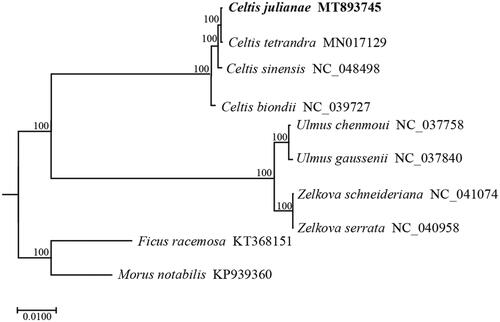Abstract
Celtis julianae C.K. Schneid. is a large deciduous tree of Ulmaceae. In this study, the chloroplast genome sequence of C. julianae was 159,064 bp in length, consisting of a large single-copy (LSC) region with 86,139 bp, a small single-copy (SSC) region with 19,137 bp, and two inverted repeat regions (IRs) with 26,894 bp. The GC content in the chloroplast genome of C. julianae was 36.3%. The chloroplast genome of C. julianae contained 127 genes, including 86 protein-coding genes, 37 tRNA genes, and four rRNA genes. Phylogenetic tree showed that C. julianae was clustered with C. tetrandra.
Celtis is a genus of Ulmaceae, including more than 60 species, widely distributed in tropical and warm regions of the world. Celtis julianae C.K. Schneid. is a large deciduous tree, more than 25 m in height, with deep green leaf and red flower (Huang and Zhao Citation2004). It also has good economic value because of its high oil content in the kernel. Celtis has many questions in relation to its genetic phylogeny and species identification.
The fresh leaf samples of C. julianae were collected in Green Expo Garden, Zhengzhou, China (N347591.8300; E1139260.3300). The voucher specimen was deposited at the Herbarium of Henan Agricultural University (voucher number: CJ-20-0715). The total genomic DNA was extracted from fresh leaves of C. julianae using a modified CTAB method (Doyle and Doyle Citation1987). Sequencing was performed with an Illumina HiSeq2500 Platform (San Diego, CA). The raw reads were generated by Illumina paired-end sequencing after removing adapters. The low quality sequences of raw reads used Fastp (https://github.com/OpenGene/Fastp) for quality control. Resultant clean reads were assembled using GetOrganelle pipeline v1.6.3a (https://github.com/Kinggerm/GetOrganelle) with the gene from Celtis sinensis (GenBank accession no. NC_048498) as the reference sequence. The genome was automatically annotated by using the CpGAVAS2 pipeline (http://www.herbalgenomics.org/cpgavas) (Shi et al. Citation2019) and start/stop codons and intron/exon boundaries were adjusted in Geneious 20.2.2 (https://www.geneious.com/).
The chloroplast genome sequences of C. julianae were submitted to NCBI, and the accession number was MT893745. The genome sequence of C. julianae was 159,064 bp in length, consisting of a large single-copy (LSC) region with 86,139 bp, a small single-copy (SSC) region with 19,137 bp, and two inverted repeat regions (IRs) with 26,894 bp. The GC content in the chloroplast genome of C. julianae was 36.3%. The chloroplast genome of C. julianae contained 127 genes, including 86 protein-coding genes, 37 tRNA genes, and four rRNA genes.
The phylogenetic tree was constructed based on the genome sequences of C. julianae in RAxML v8.2 (Stamatakis Citation2006) with 1000 bootstrap replicates. A total of 10 species were used, including four Celtis species, two Ulmus species, two Zelkova species, one Ficus species, and one Morus species as outgroup (Chen et al. Citation2016; Mao and Bi Citation2016).
As shown in the phylogenetic tree (), the 10 Ulmaceae species were organized into three clusters. One of the clusters was comprised of four genus Celtis species, which C. julianae was closely related to C. tetrandra. This result was similar to the previous phylogenetic trees based on chloroplast genome sequences of Ulmaceae (Li et al. Citation2020).
Disclosure statement
No potential conflict of interest was reported by the authors.
Data availability statement
The genome sequence data that support the findings of this study are openly available in GenBank of NCBI at https://www.ncbi.nlm.nih.gov/ under the accession no. MT893745. The associated BioProject, SRA, and Bio-Sample numbers are PRJNA670186, SRA: SRS7853389, and SAMN17035257, respectively.
Additional information
Funding
References
- Chen C, Zhou W, Huang Y, Wang Z. 2016. The complete chloroplast genome sequence of the mulberry Morus notabilis (Moreae). Mitochondrial DNA Part A. 27(4):2856–2857.
- Doyle JJ, Doyle J. 1987. A rapid DNA isolation procedure for small quantities of fresh leaf tissue. Phytochem Bull. 19:11–15.
- Huang X, Zhao L. 2004. New golden leaf cultivar of Celtis julianae ('Golden Phoenix') and its primary research. HortScience. 39(4):895D–895.
- Li J, Zhou F, Mei Y, Gu Y, Xu S, Cai S, Sun M, Wang J. 2020. The complete chloroplast genome sequence of Ulmus parvifolia (Ulmaceae). Mitochondrial DNA Part B. 5(3):2975–2976.
- Mao Q, Bi G. 2016. Complete chloroplast genome of Ficus racemosa (Moraceae). Mitochondrial DNA Part A. 27(6):4655–4656.
- Shi L, Chen H, Jiang M, Wang L, Wu X, Huang L, Liu C. 2019. CPGAVAS2, an integrated plastome sequence annotator and analyzer. Nucleic Acids Res. 47(W1):W65–W73.
- Stamatakis a. 2006. Raxml-vi-hpc: maximum likelihood-based phylogenetic analyses with thousands of taxa and mixed models. Bioinformatics. 22(21):2688–2690.

